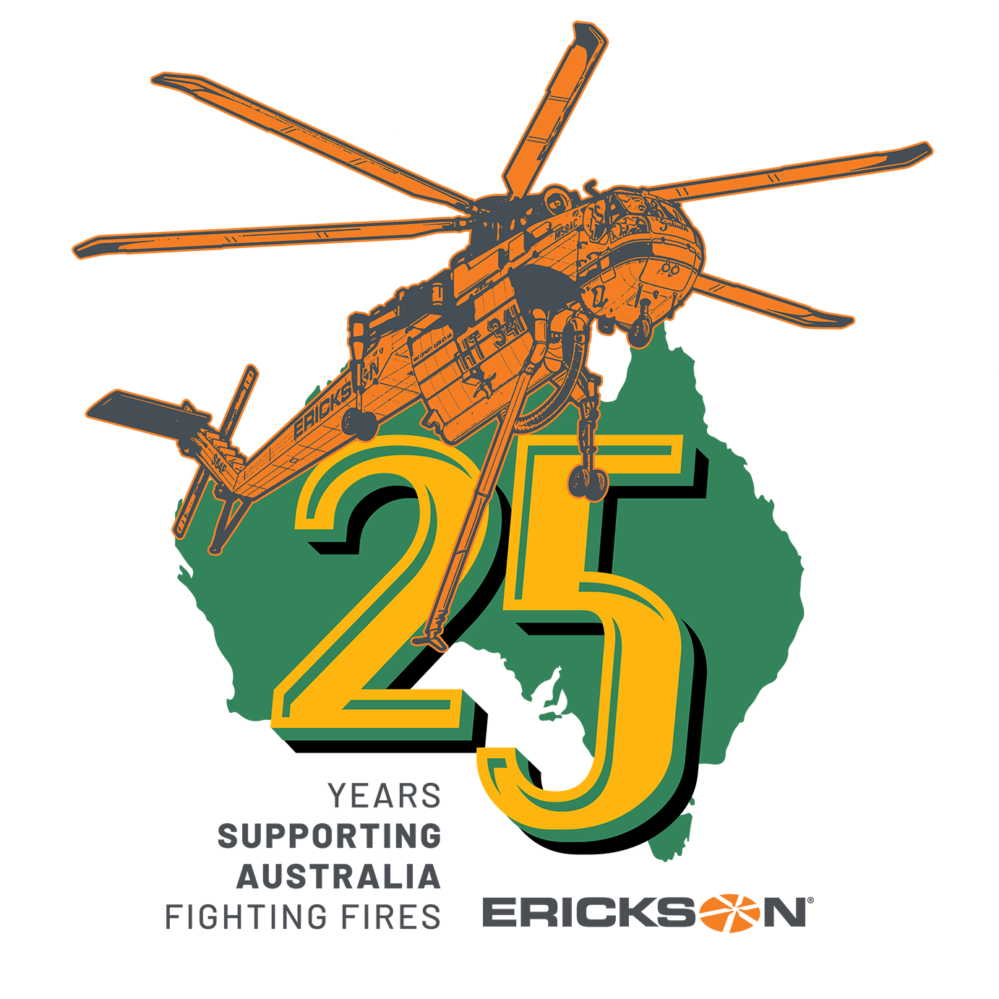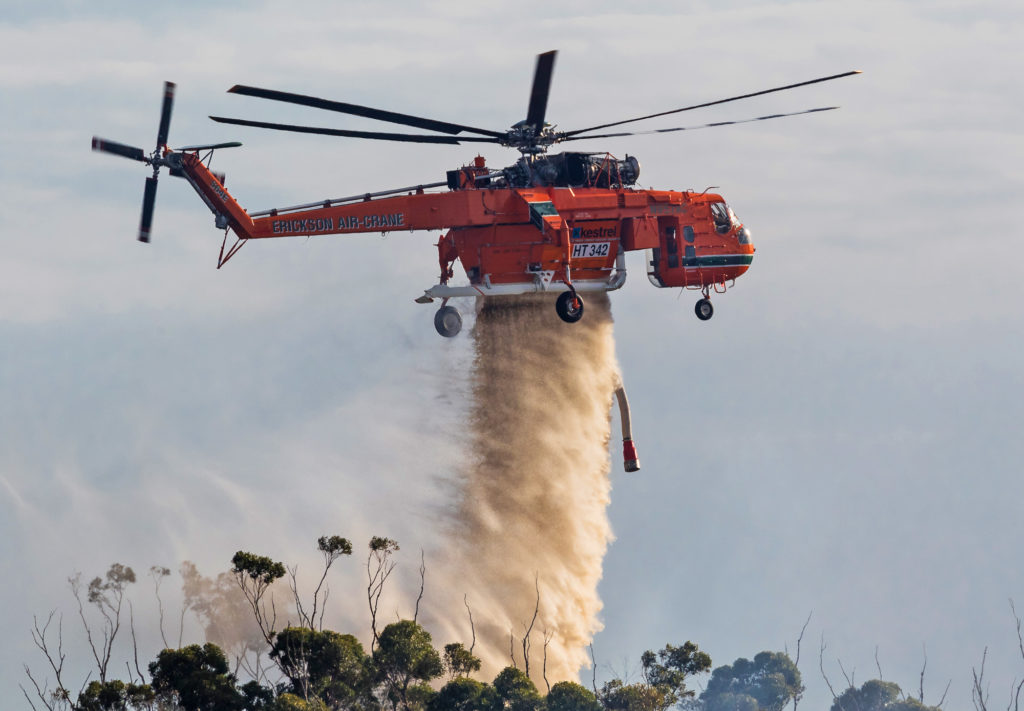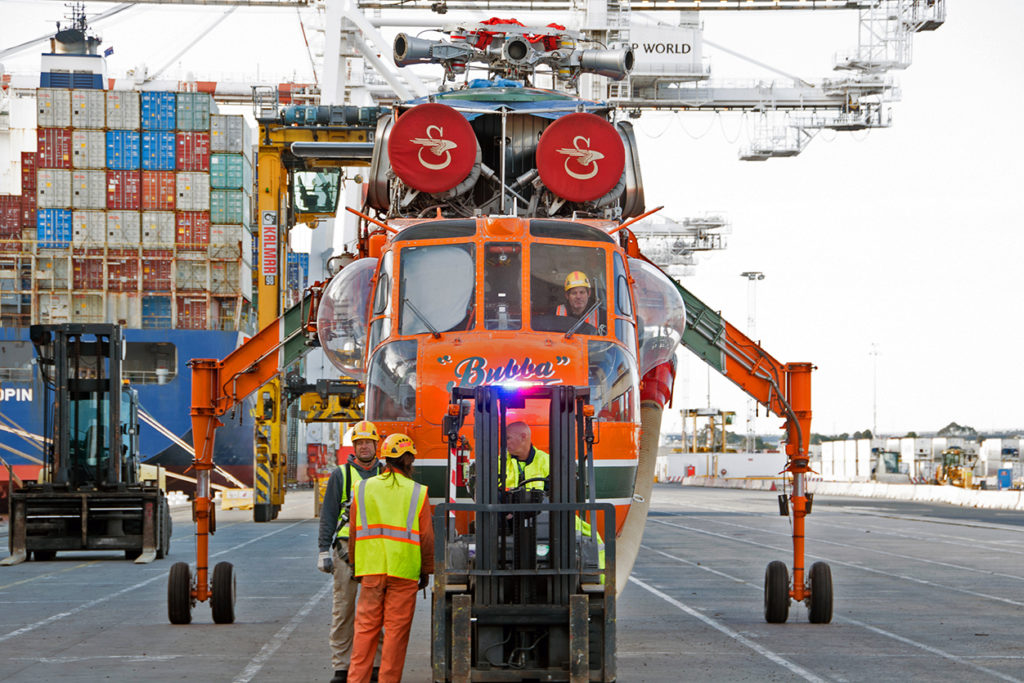
25 Remarkable Years
For 25 years, Erickson has collaborated with the National Aerial Fighting Centre (NAFC) and the Australian and New Zealand National Council for fire and emergency services (AFAC) in support of ground-level firefighters in the wildland urban interface (WUI) and Australian communities. Through this partnership, Erickson has been instrumental in fighting fires throughout parts of Western Australia, South Australia, New South Wales, and Victoria. For much of their time in Australia, six Erickson Helicopters have been stationed across Melbourne, Sydney, Adelaide, and Perth throughout the fire season. This widespread coverage has led to the S-64 Air Crane® helicopter being a recognizable and well-regarded symbol in Australian firefighting.
Significant moments in Erickson’s relationship with Australia include:
- 1997/1998: Erickson introduced the S-64 helicopter to Australian fire agencies, subsequently sending the first S-64 Air Crane® helicopter, “Millie”, into service.
- 2002: Elvis became one of Australia’s most well-known S-64 Air Crane® helitankers after saving the lives of 14 trapped firefighters in the Burragorang Valley in New South Wales. This furthered national appreciation of the distinct Air Crane® helicopter and made Elvis a renowned symbol of the collective mission.
- 2002/2003: Erickson increased their aircraft count in Australia. S-64 Air Crane® helicopters “Incredible Hulk,” “Georgia Peach,” and “Elvis” began their tenure in Australia.
- 2013: Erickson began their partnership with Kestrel Aviation, operating a fleet of six S-64 Air Crane® helicopters in Australia.
- 2019/2020: During this unprecedented fire season, the six Air Crane® helicopters stationed in Australia dropped 38.42M liters /10.15M gallons, with over 1,200 flight hours logged. On the most productive aerial firefighting day of the season, December 30, 2019, one aircraft dropped 374,657 liters/98,973 gallons, and the entire fleet of six aircraft dropped 1,173,742 liters/310,069 gallons.
To learn more about Erickson’s 25-years history in Australia, download the infographic timeline brochure.
What Sets Erickson Apart
Erickson brings a unique experience and capability set to their work in Australia. As the first company to utilize tanked helicopters for firefighting, the S-64 helicopter is the world’s most established Type-1 high-volume helicopter. Over the last 25 years of service in Australia, Erickson’s ingenuity has resulted in several substantial improvements to the S-64 Air Crane® helicopter, including:
Erickson is the only Type-1 high-volume helicopter operating in Australia to hold a Standard Category Certification. This designation signifies more rigorous safety and quality standards.
- Composite Main Rotor Blades (CMRB): Erickson created CMRBs to be aerodynamically superior to their prior metal blades, permitting the aircraft to lift more weight at higher altitudes and in hotter conditions. In 2021, an S-64F model known as Bubba was deployed in Australia; Bubba is equipped with the new Composite Main Rotor Blades (CMRBs) and a digital glass cockpit.
Advantage to Australia: CMRBs allow enhanced performance at hot and high-density altitudes which is imperative during conditions that persist throughout the fire season. - Sea Snorkel: This pioneering component gives pilots the ability to refill from saltwater and large freshwater sources in less than 30 seconds.
Advantage to Australia: Erickson’s unique ability to utilize multiple refill methods and to refill expeditiously saves valuable time and resources, increasing overall operational efficiency. - Tank Delivery Systems: Erickson’s tank delivery system can penetrate thick canopies and drop up to 2,650 U.S. gallons/10,031 Liters of water in a single load. The precision and drop pattern of the S-64 fire tank is unmatched. Air Crane® helicopters are configured to allow pilots to choose from eight different computerized coverage drop levels. They are equipped with internal firefighting foam tanks for onboard foam injection to maximize the suppression effect for each condition.
Advantage to Australia: Configurability of drop patterns is unsurpassed and allows for firefighting that is tailored to individual fires and terrain.
Erickson’s versatile fleet can not only fight bushfires but can rise to the challenge anywhere else the mission may take us, from delivering cargo in Darwin, to maneuvering through downtown Melbourne.

Erickson Associates Make the Difference
Each year, the Erickson team begins preparing for Australia’s fire season months in advance. Pilot training and flight proficiency are maintained, aircraft is mobilized, and crews are positioned to load and unload aircraft from boats or airplanes. Each logistical element is meticulously choreographed by several teams to ensure safety and operational success. Key roles that drive success year after year include:
“Erickson’s relationship and reputation with the Australian people has been largely driven by the dedication and enormous skill of the crew year after year. I feel privileged to work with a group of individuals that are so immensely dedicated to protecting people and property against environmental adversity.”
— Brandon Johnson, Australia Program
Crew Chiefs and Mechanics
Erickson field mechanics and technicians are skilled at providing comprehensive maintenance support, which includes field-level maintenance and limited depot-level maintenance (including structural repairs). They maintain the highest levels of quality workmanship to keep aircraft operational and safe throughout each mission. Typically, three mechanics are stationed per aircraft, per shift.
Pilots
Erickson pilots are world-class, with an average of 9,000 flight hours per pilot. Typically, two or three experienced pilots are staffed per aircraft, per shift. Pilots on mission this year have diverse experiences and hail from all over the globe.
A notable Erickson pilot, Kenny Chapman, is deployed on the Australia team this year and possesses over 50 years of experience as an aerial firefighter. His experience includes operations in many major countries struck annually by forest fires including Australia, Turkey, Italy, Greece, Chile, and the United States. Additionally, he was present at the launch of Erickson operations in Australia; in January of 1998, he ferried the Air Crane helicopter, Millie (N223AC), in Perth. Even more remarkably, he was piloting the famed helitanker Elvis during its lifesaving mission in the 2001-2002 season.
Program Management
Program Manager Brandon Johnson brings invaluable experience to the Australia program due to over 30 years of experience working with Erickson. Johnson’s expertise on the S-64 platform and operations includes 17 years as a Crew Chief and eight years as a Program Manager in support of Australia, Chile, Ecuador, Greece, New Caledonia, Peru, and the United States. Johnson’s application of his expertise is vital to the sustained success and operational cohesion of the program.

Looking Toward the Future
Continued innovations
As a leader in aerial firefighting, Erickson will continue our legacy of providing product and service enhancements to global customers such as Australia. An example of an upcoming development is the upgraded water cannon:
- Next Generation Water Cannon: This enhancement to our water cannon system, which is currently pending FAA approval, offers multi-directional articulation and increased distance.
Advantage to Australia: This feature is ideal for firefighting in metropolitan areas, increasing Erickson’s agility and capacity to respond to any type of firefighting condition in Australia.
2022/2023 Season and Beyond
This season, Erickson continues their nine-year partnership with Kestrel Aviation with the delivery of N163AC “Bubba” on November 28, 2022, well ahead of schedule. Erickson’s experienced crew and proven equipment are positioned to meet any challenges that arise during the 2022/2023 fire season. Additionally, Erickson is prepared to continue building upon decades of experience, knowledge, and innovation in Australia to combat the imminent rise in natural disasters such as bushfires.

